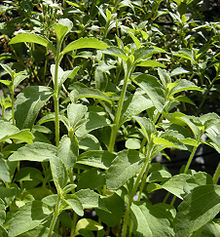Kaurans
Kaurans are secondary natural substances from the class of diterpenes . The tetracyclic kaurane structure consists of three fused-on cyclohexane rings and a cyclopentane ring that bridges a cyclohexane ring. In the seco kaurans, at least one CC bond of the kauran structure was cleaved by oxidation. Representatives of both enantiomers of the kauran structure (kauran and ent- kauran) are known, but the absolute stereochemistry is often not experimentally clarified, but only derived on the basis of analogies.
Occurrence

Kaurans occur almost exclusively in plants. Approx. 1500 different kaurans and approx. 300 seco kaurans are known, which have been detected in the following plant families in particular:
- Lamiaceae : approx. 800 kaurans. The variety is particularly great in the genus Isodon (synonym Rabdosia) .
- Asteraceae (Compositae): approx. 400 kaurans, e.g. B. in the genera Helianthus and Stevia . An example of a very poisonous kauran glycoside is the atractylosid from Atractylis gummifera .
- Annonaceae : approx. 80 kaurans, e.g. B. in the genus Xylopia
- Euphorbiaceae : approx. 40 kaurans
In fungi, 19-kauric acid in particular can be detected, which is a biosynthetic intermediate to the gibberellins that occur in both fungi and plants. Although more complex kaurans are almost exclusively produced by plants in nature, it is possible to produce kaurans by fermentation by incorporating the biosynthetic genes known from plants into cultivable microorganisms (e.g. in the yeast Saccharomyces ) . However, whether the compounds produced by this process using genetically modified yeasts can be classified as natural is controversial.
biosynthesis
The biosynthesis of the kaurans takes place via cyclization of the acyclic geranylgeraniol to the bicyclic copalyl diphosphate (diterpene skeleton labdan ). In the next step, the tetracyclic kaurane structure is formed by the enzyme kaurene synthase. Oxidations , esterifications or glycosylations only take place after cyclization to the kaurane structure. The biosynthesis of the sweet and therefore commercially interesting steviol glycosides has been clarified in detail down to the enzymatic and genetic level, so that they can be specifically produced as an expression system by means of heterologous expression of the corresponding genes in yeast .
use
Some kauran glycosides are up to 250 times sweeter than sugar. Sweet kauran glycosides, the steviosides , are mainly known from the Asteraceae Stevia rebaudiana , but are also found in other plant species, e.g. B. the rubusoside in leaves of the blackberry species Rubus suavissimus ( Rosaceae ). Extracts from Stevia rebaudiana as well as pure substances isolated from them, especially the rebaudioside A , which does not taste so much like liquorice , are used as natural sweeteners .
Individual evidence
- ↑ Pablo Anselmo García, Alaíde Braga de Oliveira, Ronan Batista: Occurrence, Biological Activities and Synthesis of Kaurane Diterpenes and their Glycosides . In: Molecules . tape 12 , no. 3 , 2007, p. 455-483 , doi : 10.3390 / 12030455 .
- ^ Dictionary of Natural Products 26.2. CRC Press, search for (Type of Compound = Kaurane and Type of Organism ) , accessed January 2, 2018.
- ↑ Miao Liu, Wei-Guang Wang, Han-Dong Sun, Jian-Xin Pu: Diterpenoids from Isodon species: an update . In: Natural Product Reports . tape 34 , no. 9 , August 30, 2017, p. 1090-1140 , doi : 10.1039 / c7np00027h , PMID 28758169 .
- ↑ H. Kawaide, R. Imai, T. Sassa, Y. Kamiya: Ent-kaurene synthase from the fungus Phaeosphaeria sp. L487. cDNA isolation, characterization, and bacterial expression of a bifunctional diterpene cyclase in fungal gibberellin biosynthesis . In: The Journal of Biological Chemistry . tape 272 , no. 35 , August 29, 1997, pp. 21706-21712 , PMID 9268298 .
- ↑ a b Patent EP2742142 : Recombinant Production of Steviol Glycosides. Published on June 18, 2014 , Applicant: Evolva SA, Inventors: Jens Houghton-Larson, Paula Hicks, Michael Naesby, Thomas Ostergaard, Jorgen Hansen, Michael Dalgaard, Espen Halkjaer, Ernoesto Simon.
- ↑ JE Brandle, PG Telmer: steviol glycosides biosynthesis . In: Phytochemistry . tape 68 , no. 14 , 2007, p. 1855-1863 , doi : 10.1016 / j.phytochem.2007.02.010 .


